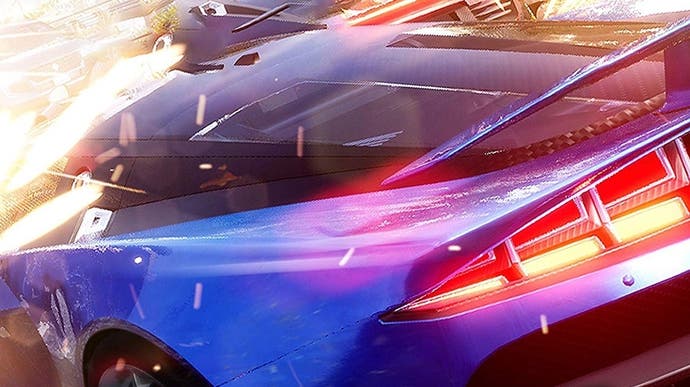Dangerous Driving's sublime action and handling works best at 60fps
How PC, Pro and X power ahead of the standard consoles.
At what point do you release that Three Fields Entertainment really has delivered a worthy homage to the classic Burnout? For me, it's really simple - it's all about the boost drift. An arcade racing game is nothing without its drift mechanic, and in Dangerous Driving it's the key to sustaining maximum velocity - essential not just for the racing and not just for the boost chains (or heat waves, as they're now known) but also in maintaining ramming speed for those classic Takedowns. And yes, the good news is that Dangerous Driving doesn't just nail sublime handling, the gladiatorial racing combat works beautifully too.
But the new Three Fields game isn't really that most eagerly awaited of things - the so-called 'spiritual successor to Burnout' - because fundamentally, we're looking at a small indie game here following in the footsteps of what eventually evolved into an EA triple-A juggernaut, before the firm bizarrely mothballed the franchise. Dangerous Driving was built by a team of seven using Unreal Engine 4 - a far cry from the fully staffed up Criterion, often rebuilding its technology from the ground up from one title to the next. With Dangerous Driving, the end result is something different then - the innovation is poured into game mechanics and race modes rather than into a vast array of complex maps and cars.
Playing Dangerous Driving, I think my colleague John Linneman hits the nail on the head: this is Burnout 3 viewed through the lens of Burnout 1, with the original game's lower budget and stripped back presentation, merged with the raw essence of what made Burnout 3 so satisfying to play. Visually, the game may lack some of the variety of later Burnout games, but technically it's on point: UE4 delivers a clean, post-process-heavy presentation and a wonderful motion blur implementation that accentuates the brutal speed this game delivers. However, the use of Unreal also underscores the wide divide in the Dangerous Driving experience depending on whether you're playing on base or enhanced consoles.
Both vanilla consoles and PS4 Pro render at 1080p, while Xbox One X bumps up clarity to 1440p but the difference in frame-rate targets is crucial here: the standard machines run at 30fps, while their enhanced equivalents hit 60fps. Danger Zone 2 offered the chance to switch between quality and performance modes on Xbox One X, but couldn't quite sustain 1080p60, so I was a little concerned about Dangerous Driving going in. However, the good news here is that the new game gets extremely close to locking to that super-smooth, consistent frame-rate - especially so on PlayStation 4 Pro. Xbox One X gets close to Pro's standard, with just the odd performance hiccup. Also strange is that both versions see minor frame-rate hitching when text appears on-screen mid-race. Both consoles do this, but the X sees it happen more frequently. By and large though, both of the enhanced consoles run really well - and away from the PC release, this is the best way to play.
After the joys of Pro and X, the standard PlayStation 4 and Xbox One don't quite deliver the same thrills. The 30fps update could work - after all, Criterion's Need for Speed: Hot Pursuit was brilliant - but the base console action is punctuated by inconsistent frame delivery, with new frames arriving at 16ms, 33ms and 50ms intervals, giving a stuttering look to the game even though its actual frame-rate is indeed 30fps. Locking each frame to a 33ms persistence is a key method in delivering consistency to half-refresh racing games, going all the way back to the original Ridge Racer on PS1, so it's surprising to see this issue. If this doesn't bother you, you're good to go, but I just don't feel that this is the best way to play the game.
The Eurogamer Recommended review points out that the experience may be too pared back for some but viewed as a modernised retro experience for current-gen machines built by a talented indie studio, I don't feel there's much to complain about here - with one exception: the lack of in-game music. Aside from a title screen track, there's no other music, which does present some issues. If you have a Spotify premium account, you can plug in your playlists but if you don't, you'll need to use external solutions. I called upon Alexa, while John preferred to run some music discs through his Philips CD-i (yes, really). This helps to bridge the gap, but the lack of musical stings - a celebratory fanfare on winning a race, for example - does feel like one budget cut too far. The lack of audio (and animation) on loading screens also serves to make them feel longer than they actually are, though the Burnout 3 homage in the make-up of the tips screens certainly stokes nostalgia.
Overall, I have two main takeaways from my time with Dangerous Driving. Firstly, while many of the latter-day triple-A trimmings from later franchise entries are absent, the essence of the original trilogy is present and correct - and once you lock into the action, it's difficult to stop playing, and I suspect that this is exactly what Burnout series purists want. The second takeaway is all about evolution - Danger Zone 2 was a promising step-up from TFE, but the firm has come on leaps and bounds with the arrival of Dangerous Driving. The idea is that Three Fields uses the innovations from each new title as the foundations on which to build their next. And based on what the team has delivered here, whatever it comes up with next should be well worth looking out for.












